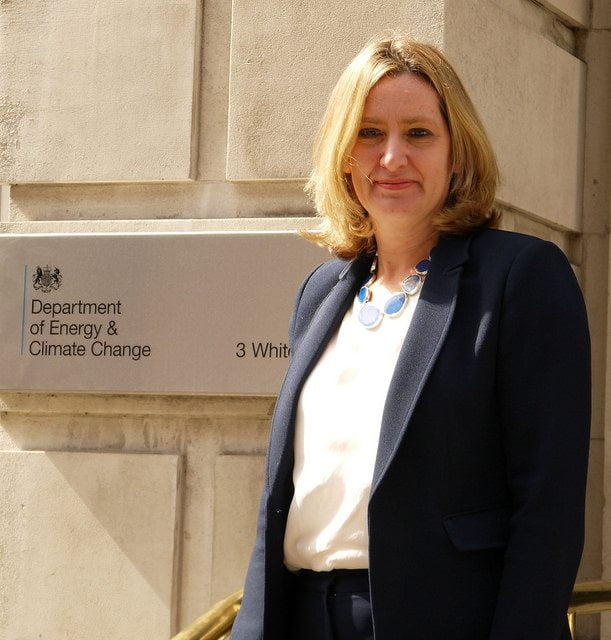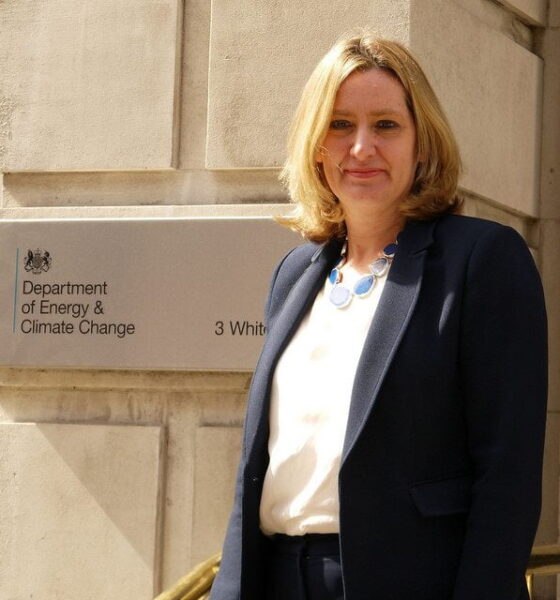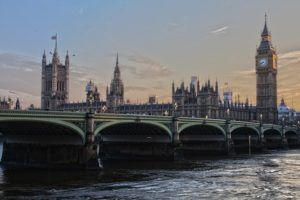

Economy
Amber Rudd’s speech on a new direction for UK energy policy
Amber Rudd: “Tough on subsidies. Concentrating on technologies that will deliver at scale. New gas replacing coal. Getting new nuclear off the ground. Reducing the costs of offshore wind. And unleashing innovation to discover the clean and cheap technologies of tomorrow.”
There’s a picture from the Government art collection that hangs in the Department of Energy and Climate Change. It’s called “At the Coal Face” by Nicholas Evans.
Rendered in black and white, it shows a pair of miners with shovels and picks, muscles straining as they work at a seam. It’s a very powerful picture.
For me as Secretary of State for Energy and Climate Change, it’s a constant reminder that the efforts made to heat and light our homes; to power our businesses and economy; are, and have always been, a very human endeavour. Our energy system is a miracle of human ingenuity, industry and innovation.
Many decades of engineering brilliance and hard, often dangerous work has produced a system which takes the natural raw material of coal and gas and oil (and now the wind and sun) and moulds them into something that powers our lives.
Most of us take energy for granted. The lights come on when we want them to and that’s exactly as it should be.
Our modern society simply cannot function without power.
Energy security has to be the number one priority.
But no responsible government should take a risk on climate change either.
Because it’s one of the greatest long-term threats to our economic security.
So the challenge we face is how we make sure that energy remains as the backbone of our economy, while we transform to a low carbon system.
How do we achieve an energy system that is secure; affordable; and clean?
Energy Policy in Context
That picture, ‘At the Coal Face’, is also a historical record.
Drawn in 1978, the year of the winter of discontent, the decade of the ‘three day week’, for me, it conjures up a Britain from a wholly different age.
[Political content redacted]
Since then Britain’s energy system has been shaped in two distinct phases.
The first of these was the break-up of the large nationalised energy monopolies set in train by Nigel Lawson.
Competition
In his seminal speech in 1982, he defined the Government’s role as setting a framework that would ensure the market, rather than the state, provided secure, cost-efficient energy.
This was driven by a desire to create a system where competition worked for families and businesses.
“The changes in prospect,” said Lawson at the time, “will help us ensure that the supplies of fuel we need are available at the lowest practicable cost.”
[Political content redacted]
Allowing markets to flourish. Open to trading. Independent regulation to provide confidence to investors. Competition keeping prices as low as possible.
Of course, the market that was created was not free from all government intervention. Markets never are.
Intervention was necessary then and will always remain so in an industry that delivers such a vital service.
But intervention was limited.
Intervention
The second phase of modern energy policy began when Tony Blair signed the Renewable Energy Target in 2007.
What has this left us with?
We now have an electricity system where no form of power generation, not even gas-fired power stations, can be built without government intervention.
And a legacy of ageing, often unreliable plant.
Perversely, even with the huge growth in renewables, our dependence on coal, the dirtiest fossil fuel, hasn’t been reduced.
Indeed a higher proportion of our electricity came from coal in 2014 than in 1999.
So we still haven’t found the right balance.
We need a course correction using the tools we have already developed through Electricity Market Reform.
We know competition works. It keeps costs low and can deliver a clean and reliable energy system.
We want a consumer-led, competition focussed energy system that has energy security at the heart of it and delivers for families and businesses.
We want to see a competitive electricity market, with government out of the way as much as possible, by 2025.
Getting there will not be easy. The process of privatisation itself spanned five Parliaments.
Indeed, moving to a new model without risking energy security will require government to continue to intervene. But that should diminish over time.
We need to start that work now.
So how do we do that?
Energy Security
It may sound a strange thing to say, but fundamentally, I want energy policy to be boring.
One that people going about their daily lives don’t need to worry about, because they trust that the system produces energy that is reliable and affordable and, indeed, isn’t damaging to the environment.
Frankly, if at all possible, energy policy shouldn’t be noticed.
That is why energy security has to be the first priority – it is fundamental to the health of our economy and the lives of our people.
It underpins everything we need to do.
Gas
In some areas the system works well.
The gas used to heat our homes is amongst the cheapest and most secure in Europe.
And this is despite the decline in our domestic gas production from the North Sea.
How has this been achieved?
Investors, driven by a desire to make a profit, have built new LNG terminals and pipelines that have improved diversity of supply.
In this case, energy security has been best served by government staying out of the way and allowing markets to find an answer.
Of course we can’t be complacent. We currently import around half of our gas needs, but by 2030 that could be as high as 75%.
That’s why we’re encouraging investment in our shale gas exploration so we can add new sources of home-grown supply to our real diversity of imports.
There are also economic benefits in building a new industry for the country and for communities.
Our North Sea history means the UK is a home to world class oil and gas expertise, in Aberdeen and around the UK – we should build on that base so that our shale potential can be exploited safely.
Electricity
But in the supply of electricity, with falling margins, there’s a greater challenge.
I am confident the steps we’ve taken alongside National Grid and Ofgem will ensure the security of supply in the next few years.
But, frankly, it cannot be satisfactory for an advanced economy like the UK to be relying on polluting, carbon intensive 50-year-old coal-fired power stations.
Let me be clear: this is not the future.
We need to build a new energy infrastructure, fit for the 21st century.
Much of that is already in the pipeline – new gas, such as the plant at Carrington, and of course, a large increase in renewables over the next five years and in the longer-term, new nuclear.
At the same time, we are building new interconnectors to make it easier to import cheaper electricity from Europe.
These changes are vital. Cheaper energy means lower household bills – something which matters to all of us.
But this isn’t just about making savings.
It’s about the long term security of our energy supply.
And my view is that is best served through open, competitive markets.
That is why the Prime Minister has been calling for an ambitious Energy Union for Europe – to save hardworking families money and to guarantee energy supplies for future generations.
So we welcome the report out from the EU today on the “State of the Energy Union” which lays out the steps Europe needs to take to strengthen our partnership.
And I can say to Europe that Britain stands ready to help make this vision a reality.
This is an example of where we can achieve more working together than alone, and where Europe can adapt to help its citizens where it matters to them.
But we do need to do more at home.
In the next 10 years, it’s imperative that we get new gas-fired power stations built.
We need to get the right signals in the electricity market to achieve that.
We are already consulting on how to improve the Capacity Market.
And after this year’s auction we will take stock and ensure it delivers the gas we need.
Nuclear
Gas is central to our energy secure future.
So is nuclear.
Opponents of nuclear misread the science. It is safe and reliable.
The challenge, as with other low carbon technologies, is to deliver nuclear power which is low cost as well. Green energy must be cheap energy.
But innovation is not just about trying things out in a lab and magically discovering a new energy source.
It is also about testing things at scale.
We learn from doing.
In the 13 years of the last Labour government not a single new nuclear power station was commissioned.
We are dealing with a legacy of under-investment and with Hinkley Point C planning to start generating in the mid 2020s that is already changing.
It is imperative we do not make the mistakes of the past and just build one nuclear power station.
There are plans for a new fleet of nuclear power stations, including at Wylfa and Moorside.
This could provide up to 30% of the low carbon electricity which we’re likely to need through the 2030s and create 30,000 new jobs.
This will provide low carbon electricity at the scale we need.
Climate change is a big problem, it needs big technologies.
As the former Chief Scientist at DECC, David Mackay, said: “If everyone does a little, we’ll achieve only a little. We must do a lot. What’s required are big changes.”
Offshore Wind
That’s why we should also support the growth of our world leading offshore wind industry.
In the global context this is a technology which has the scale to make a big difference.
It is one area where the UK can help make a lasting technological contribution.
On current plans we expect to see 10GW of offshore wind installed by 2020.
This is supporting a growing installation, development and blade manufacturing industry. Around 14,000 people are employed in the sector.
This ground breaking expertise has helped the costs of contracts for offshore wind come down by at least 20% in the last two years.
But it is still too expensive.
So our approach will be different – we will not support offshore wind at any cost.
Further support will be strictly conditional on the cost reductions we have seen already accelerating.
The technology needs to move quickly to cost-competitiveness.
If that happens we could support up to 10GW of new offshore wind projects in the 2020s.
The industry tells us they can meet that challenge, and we will hold them to it.
If they don’t there will be no subsidy.
No more blank cheques.
Today I can announce that – if, and only if, the Government’s conditions on cost reduction are met – we will make funding available for three auctions in this Parliament.
We intend to hold the first of these auctions by the end of 2016.
Investors have a right to clarity on our objectives. And that is what I am providing today.
New nuclear, new gas and, if costs, come down, new offshore wind will all help us meet the challenge of decarbonisation.
The Purpose of Decarbonisation
But is important to pause and answer this question: ‘what are we decarbonising for?’
Climate action is about our future economic security.
As the Foreign Secretary said last week: “In every other facet of life, we assess the risks and where the risk of occurrence is high and the impacts are potentially catastrophic, we act to mitigate and to prevent. Our approach to climate change should be no different.”
Action on climate change is linked to the action we’re taking now to reduce the deficit. It is about resilience now and in the future.
But climate change is a global problem, not a local one.
Action by one state will not solve the problem. It’s what we do together that counts.
And that is why achieving a global deal in Paris next month is so important.
A Global Deal
Paris is a city that is currently in mourning.
But in a less than two weeks’ time, we will see the leaders of the world gather there in solidarity to seek to achieve the first truly global deal on climate change.
Since I became Secretary of State I have been working with my counterparts in India, China, the US, Europe and others across the globe to help make sure we come to Paris in the best place possible.
The commitments countries have made so far are significant and a deal is tantalisingly close.
This much I know, climate change will not be solved by a group of over-tired politicians and negotiators in a conference centre.
It will take action by businesses, civil society, cities, regions and countries.
Paris must deliver a clear signal that the future is low carbon that unleashes the levels of private investment and local action needed.
Collective action works when you share the burden fairly, but also when each makes a distinctive contribution. We know that in isolation, cuts to Britain’s own greenhouse gas emissions, just 1.2% of the global total, would do little to limit climate change.
So we have to ask ourselves the important question:
What is the UK’s role in that global decarbonisation? Where can we make a difference?
Controlling Costs
Our most important task is providing a compelling example to the rest of the world of how to cut carbon while controlling costs.
As I set out earlier, it is not clear we have done that so far.
The Climate Change Act, which the Conservatives helped create, is a good model that is being copied by other countries
Long-term time-tables, regular budgets, independent review.
We are committed to meeting the UK’s 2050 target.
We are on track for our next two carbon budgets.
But it’s clear, as the Committee on Climate Change has said, that the fourth carbon budget is going to be tough to achieve.
We do need to meet that challenge, but we need be pragmatic too.
We will need action right across the economy: in transport; waste and buildings.
And we’ll be setting out our plans for meeting the fourth and fifth Carbon Budgets next year.
But simply meeting the targets we have set ourselves will not be example enough for the rest of the world to follow.
We need to get the right balance between supporting new technologies and being tough on subsidies to keep bills as low as possible.
We can only expect bill payers to support low carbon power, as long as costs are controlled.
I inherited a department where policy costs on bills had spiralled.
Subsidy should be temporary, not part of a permanent business model.
Most importantly, new, clean technologies will only be sustainable at the scale we need if they are cheap enough. When costs come down, as they have in onshore wind and solar, so should support.
For instance, we have enough onshore wind in the pipeline to meet our 2020 expectations.
That is why we set out in our manifesto that we would end any new public subsidy for onshore wind farms. The costs of solar have come down too.
Over 8GW of solar is already deployed and even with the costs controls we have proposed we expect to have around 12GW in place by 2020.
These technologies will be cost-competitive through the 2020s.
We need to work towards a market where success is driven by your ability to compete in a market. Not by your ability to lobby Government.
This will only be possible if carbon pricing works properly.
Despite its flaws, the EU Emissions Trading Scheme is exactly the kind of intervention that should be made at a European level where collective action is more powerful.
The UK has worked hard with others to get major reforms that are helping restore a more stable and robust price on carbon.
But I’m determined that we help deliver more this Parliament to restore the ETS to full health.
In the same way generators should pay the cost of pollution, we also want intermittent generators to be responsible for the pressures they add to the system when the wind does not blow or the sun does not shine.
Only when different technologies face their full costs can we achieve a more competitive market.
Coal
To set an example to the rest of the world, the UK also has to focus on where we can get the biggest carbon cuts, swiftly and cheaply.
That is hard to do when, after 20 years of action on climate change, 30% of our electricity still comes from unabated coal.
One of the greatest and most cost-effective contributions we can make to emission reductions in electricity is by replacing coal fired power stations with gas.
For centuries coal has played a central role in our energy system.
But it’s the most carbon intensive fossil fuel and damages air quality.
Gas produces half the carbon emissions of coal when used for power generation.
Unabated coal is simply not sustainable in the longer term.
In an ideal world, the carbon price provided by the ETS would phase out coal for us using market signals. But it’s not there yet.
So I want to take action now.
I am pleased to announce that we will be launching a consultation in the spring on when to close all unabated coal-fired power stations.
Our consultation will set out proposals to close coal by 2025 – and restrict its use from 2023.
If we take this step, we will be one of the first developed countries to deliver on a commitment to take coal off the system.
But let me be clear, we’ll only proceed if we’re confident that the shift to new gas can be achieved within these timescales.
Innovation
Let’s be honest with ourselves, we don’t have all the answers to decarbonisation today.
We must develop technologies that are both cheap and green.
This means unleashing innovation.
Innovation is not just about investing money in new bits of kit.
Government’s first job is to create the environment for new ideas to flourish by getting rid of the barriers that in the way. Some argue we should adapt our traditional model dominated by large power stations and go for a new, decentralised, flexible approach.
Locally-generated energy supported by storage, interconnection and demand response, offers the possibility of a radically different model.
It is not necessarily the job of Government to choose one of these models.
Government is the enabler. The market will reveal which one works and how much we need of both
A Smarter System
Smart meters are a key building block of an approach that could allow that.
Every home and small business in Britain will get them by the end of 2020.
And this is sparking some real entrepreneurial innovation.
Devices providing real-time feedback and apps are being developed that will help people work out where they are wasting energy.
This isn’t about technology for technology’s sake – it’s about using it to keep people’s bills low – and making the overall system more efficient.
A fully smart energy system could help us to reduce costs by tens of billions of pounds over the decades ahead. So are now with Ofgem to assess what we can do.
For instance, I already have agreed with Ofgem that by early 2017 they will remove the barriers to suppliers choosing half-hourly settlement for household customers.
This will allow suppliers to offer new Time of Use tariffs so people can get a cheaper deal based on when they use energy, not necessarily how much.
We are also looking at removing other regulations that are holding back smart solutions, such as demand side response and storage.
I will shortly be launching a paper setting out some of the possibilities and we will consult formally in the spring to allow action in the autumn.
Independent Regulation
National Grid as system operator has played a pivotal role in keeping the energy market working.
But as our system changes we need to make sure it is as productive, secure and cost-effective as possible.
There is a strong case for greater independence for the system operator to allow it to make the necessary changes.
So, alongside the National Infrastructure Commission, we will work with National Grid, Ofgem and others to consider how to reform the current system operator model to make it more flexible and independent.
Independent regulation is central to a competitive market.
It’s right that Ofgem is an independent voice championing competition and cracking down when companies have treated customers badly.
That is also why we are creating the independent Oil and Gas Authority.
The North Sea still offers significant value for the UK – up to 20 billion barrels of oil equivalent could still be extracted and the industry supports 375,000 jobs.
But we need to provide clarity to investors in UK oil production
Today I am launching a consultation on a Strategy to Maximise the Economic Recovery of the North Sea.
The principle objectives this Strategy is designed to meet have been challenged and amended in the Energy Bill by the House of Lords.
We intend to overturn this amendment when the Bill is considered in the Commons.
Innovation in Supply
This system of independent regulation, alongside some of the changes we made in the last Parliament, creates the conditions for competition and innovation to flourish.
This has led to greater competition in the supply market.
There are now 26 independent suppliers and their market share has grown from under 1% in 2010 to over 13% now. And the Big 6 are losing market share every quarter.
Innovative, new suppliers, which range from start-ups to local authorities, are demonstrating how competition is working for people.
But the market is still far from perfect which is why the Competition and Markets Authority is undertaking the biggest investigation into the energy market since privatisation.
Its interim findings were not pretty for the large energy suppliers.
It remains frustrating to me that the falls in wholesale gas prices have not been passed on to most households.
This has to change.
It is also not clear that all business customers are benefiting from competition in a market that lacks transparency. The CMA shouldn’t duck these issues.
Heat
Nowhere in the energy system is the need for innovation more acute than in how we use heat to keep warm in our homes and for industrial processes.
Heat accounts for around 45% of our energy consumption and a third of all carbon emissions.
Progress to date has been slower here than in other parts of our economy.
There are Technologies which have great potential, such as district heating, biogas, hydrogen and heat pumps. But it is not yet clear which will work at scale.
So different approaches need to be tested.
We need a long-term plan that will work and keeps down costs for consumers.
We will set out our approach next year, as part of our strategy to meet our carbon budgets.
Energy Efficiency
Of course, one of the best ways to cut bills and cut carbon is to cut energy use itself.
That’s why energy efficiency is so important.
For businesses, energy efficiency can reduce costs, which in turn improves productivity and competitiveness.
But the tax and policy framework designed to encourage this is complex and we are now looking at streamlining it.
More than 1.2 million households are seeing lower bills due to energy efficiency improvements over the last 5 years.
We are committed to ensuring a million more get the same benefits by the end of this Parliament.
But I am determined that help through the Energy Company Obligation is concentrated on those in greatest need.
They are the ones who live in damp and draughty homes, and they who need the most help to cut their bills.
Research and Development
So as I have said, we need to reinvigorate competition, make markets work for consumers, and build a smarter system.
Important as these steps are, they are not enough to unleash the innovation we need.
New technologies at the scale we need don’t appear out of thin air.
Nuclear power, gas-fired power stations and even shale gas emerged after years, sometimes decades of public support.
It takes the brilliance of business to commercialise them, but it often takes the patience of Government support to get them off the ground.
Energy research and development has been neglected in recent years in favour of the mass deployment of all renewable technologies.
We do not think this is right.
We cannot support every technology.
Our intervention has to be limited to where we can really make a difference – where the technology has the potential to scale up and to compete in a global market without subsidy.
DECC funding for innovation is already supporting the development of transformative technologies here in the UK. In energy storage, in low carbon transport fuels, in more efficient lighting.
These and many more examples, such as CCS, point to the creation of new industries and new jobs in the UK.
We must also build on our rich nuclear heritage and become a centre for global nuclear innovation.
This means exploiting our world leading technical expertise at centres of excellence at universities in Manchester, Sheffield and Lancaster.
It also means exploring new opportunities like Small Modular Reactors, which hold the promise of low cost, low carbon energy.
Conclusion
So ladies and gentlemen, this is the way forward:
Greater competition.
Tough on subsidies.
Concentrating on technologies that will deliver at scale.
New gas replacing coal.
Getting new nuclear off the ground.
Reducing the costs of offshore wind.
And unleashing innovation to discover the clean and cheap technologies of tomorrow.
Government should enable, not dictate.
The market should lead our choices.
Because that is the way to keep costs as low as possible.
By 2025, with a new nuclear power station built, offshore wind competing with other renewables, unabated coal a thing of the past, and smart energy coming into its own we will have transformed our energy system.
But we must remind ourselves why we are doing any of this.
Energy security provides the foundation of our future economic success. It is the top priority.
Secure energy so people can get on with their lives.
Affordable energy so the people that foot the bill, the households and businesses of Britain, get a good deal.
And clean energy to safeguard our future economic security.


 Environment10 months ago
Environment10 months agoAre Polymer Banknotes: an Eco-Friendly Trend or a Groundswell?

 Environment11 months ago
Environment11 months agoEco-Friendly Home Improvements: Top 7 Upgrades for 2025

 Features9 months ago
Features9 months agoEco-Friendly Cryptocurrencies: Sustainable Investment Choices

 Features10 months ago
Features10 months agoEco-Friendly Crypto Traders Must Find the Right Exchange



























